Analyzing Factors Affecting Job Design and Employee Performance
VerifiedAdded on 2023/06/15
|7
|2156
|410
Essay
AI Summary
This essay delves into the multifaceted realm of organizational behavior, scrutinizing the factors that significantly impact employee performance and overall organizational success. It begins by dissecting the key elements influencing job design, encompassing organizational features, environmental considerations like employee skills, and behavioral factors such as autonomy and feedback. The essay further explores the importance of a positive work environment, highlighting communication, appreciation, teamwork, trust, and positive thinking as crucial components. Goal-setting theory is discussed as a mechanism for aligning employee behavior with organizational objectives, emphasizing the need for specific, measurable, and feedback-driven goals. Furthermore, the role of motivation is examined, with leadership, rewards, recognition, and supportive schemes identified as key motivators. The essay concludes by emphasizing the importance of both financial and non-financial rewards in attracting, retaining, and motivating employees, ultimately contributing to enhanced organizational performance. Desklib provides access to a wide range of study resources, including solved assignments and past papers, to support students in their academic endeavors.

Running head: ORGANIZATIONAL BEHAVIOR
Organizational Behavior
Name of the Student
Name of the University
Author note
Organizational Behavior
Name of the Student
Name of the University
Author note
Paraphrase This Document
Need a fresh take? Get an instant paraphrase of this document with our AI Paraphraser
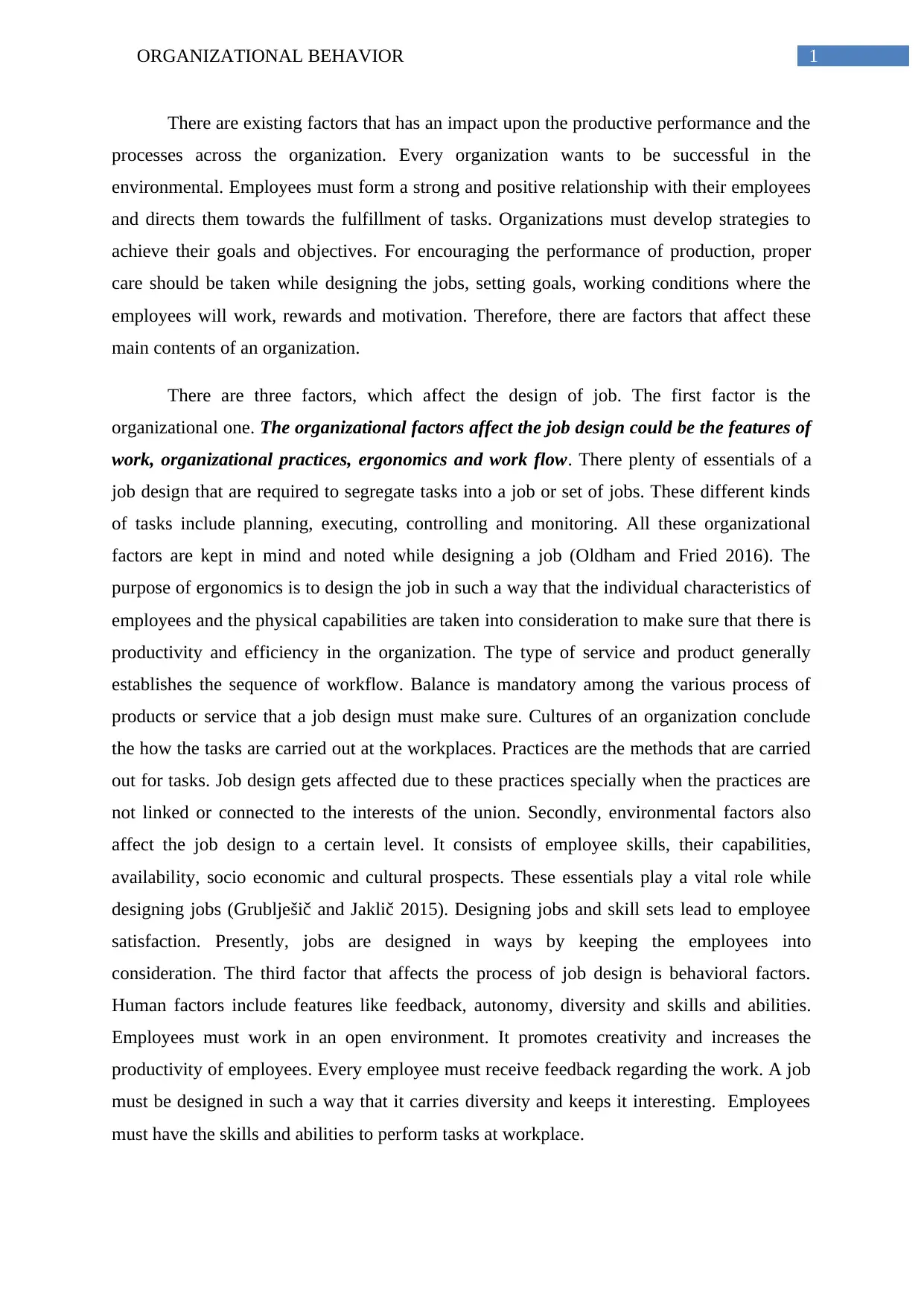
1ORGANIZATIONAL BEHAVIOR
There are existing factors that has an impact upon the productive performance and the
processes across the organization. Every organization wants to be successful in the
environmental. Employees must form a strong and positive relationship with their employees
and directs them towards the fulfillment of tasks. Organizations must develop strategies to
achieve their goals and objectives. For encouraging the performance of production, proper
care should be taken while designing the jobs, setting goals, working conditions where the
employees will work, rewards and motivation. Therefore, there are factors that affect these
main contents of an organization.
There are three factors, which affect the design of job. The first factor is the
organizational one. The organizational factors affect the job design could be the features of
work, organizational practices, ergonomics and work flow. There plenty of essentials of a
job design that are required to segregate tasks into a job or set of jobs. These different kinds
of tasks include planning, executing, controlling and monitoring. All these organizational
factors are kept in mind and noted while designing a job (Oldham and Fried 2016). The
purpose of ergonomics is to design the job in such a way that the individual characteristics of
employees and the physical capabilities are taken into consideration to make sure that there is
productivity and efficiency in the organization. The type of service and product generally
establishes the sequence of workflow. Balance is mandatory among the various process of
products or service that a job design must make sure. Cultures of an organization conclude
the how the tasks are carried out at the workplaces. Practices are the methods that are carried
out for tasks. Job design gets affected due to these practices specially when the practices are
not linked or connected to the interests of the union. Secondly, environmental factors also
affect the job design to a certain level. It consists of employee skills, their capabilities,
availability, socio economic and cultural prospects. These essentials play a vital role while
designing jobs (Grublješič and Jaklič 2015). Designing jobs and skill sets lead to employee
satisfaction. Presently, jobs are designed in ways by keeping the employees into
consideration. The third factor that affects the process of job design is behavioral factors.
Human factors include features like feedback, autonomy, diversity and skills and abilities.
Employees must work in an open environment. It promotes creativity and increases the
productivity of employees. Every employee must receive feedback regarding the work. A job
must be designed in such a way that it carries diversity and keeps it interesting. Employees
must have the skills and abilities to perform tasks at workplace.
There are existing factors that has an impact upon the productive performance and the
processes across the organization. Every organization wants to be successful in the
environmental. Employees must form a strong and positive relationship with their employees
and directs them towards the fulfillment of tasks. Organizations must develop strategies to
achieve their goals and objectives. For encouraging the performance of production, proper
care should be taken while designing the jobs, setting goals, working conditions where the
employees will work, rewards and motivation. Therefore, there are factors that affect these
main contents of an organization.
There are three factors, which affect the design of job. The first factor is the
organizational one. The organizational factors affect the job design could be the features of
work, organizational practices, ergonomics and work flow. There plenty of essentials of a
job design that are required to segregate tasks into a job or set of jobs. These different kinds
of tasks include planning, executing, controlling and monitoring. All these organizational
factors are kept in mind and noted while designing a job (Oldham and Fried 2016). The
purpose of ergonomics is to design the job in such a way that the individual characteristics of
employees and the physical capabilities are taken into consideration to make sure that there is
productivity and efficiency in the organization. The type of service and product generally
establishes the sequence of workflow. Balance is mandatory among the various process of
products or service that a job design must make sure. Cultures of an organization conclude
the how the tasks are carried out at the workplaces. Practices are the methods that are carried
out for tasks. Job design gets affected due to these practices specially when the practices are
not linked or connected to the interests of the union. Secondly, environmental factors also
affect the job design to a certain level. It consists of employee skills, their capabilities,
availability, socio economic and cultural prospects. These essentials play a vital role while
designing jobs (Grublješič and Jaklič 2015). Designing jobs and skill sets lead to employee
satisfaction. Presently, jobs are designed in ways by keeping the employees into
consideration. The third factor that affects the process of job design is behavioral factors.
Human factors include features like feedback, autonomy, diversity and skills and abilities.
Employees must work in an open environment. It promotes creativity and increases the
productivity of employees. Every employee must receive feedback regarding the work. A job
must be designed in such a way that it carries diversity and keeps it interesting. Employees
must have the skills and abilities to perform tasks at workplace.
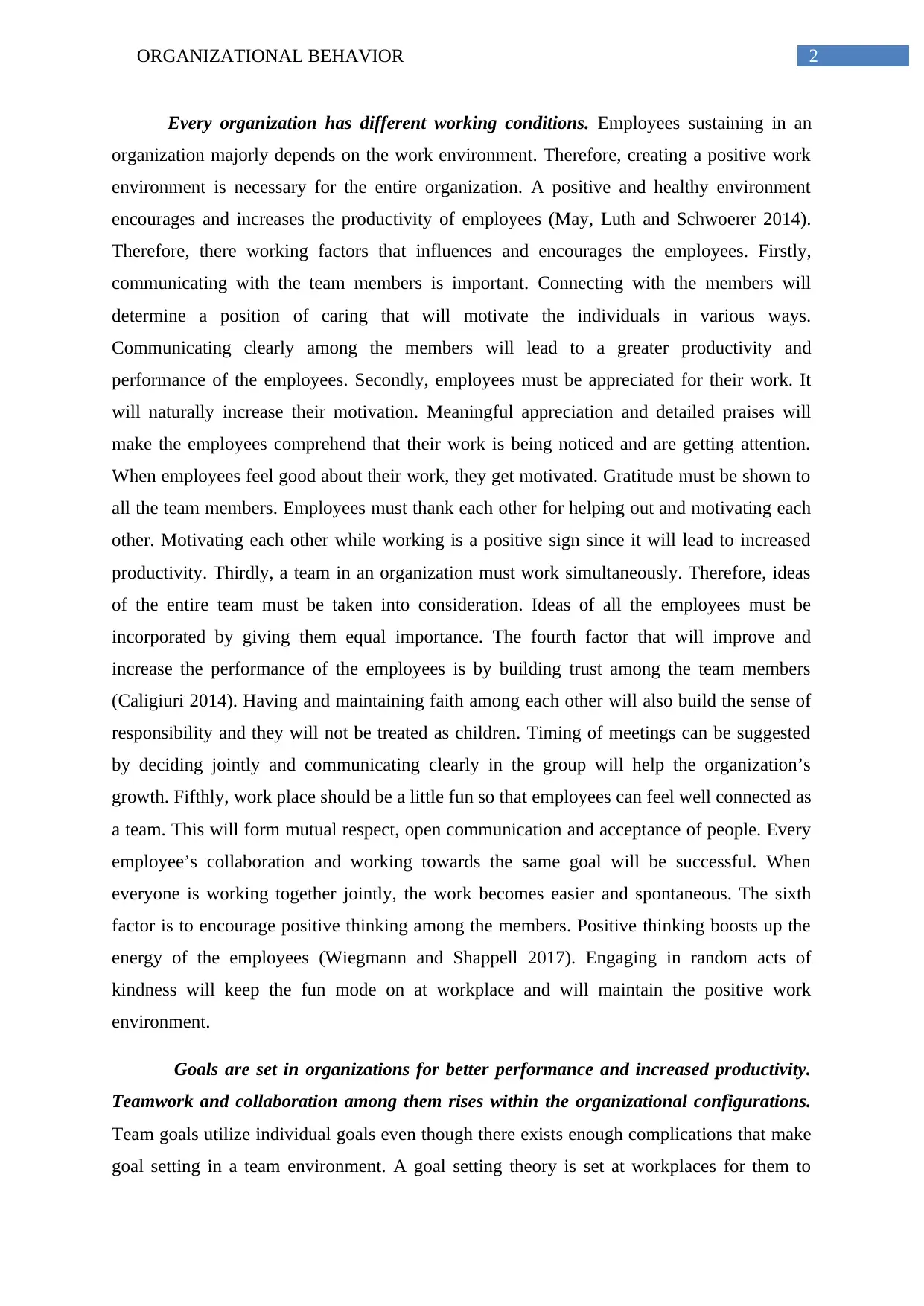
2ORGANIZATIONAL BEHAVIOR
Every organization has different working conditions. Employees sustaining in an
organization majorly depends on the work environment. Therefore, creating a positive work
environment is necessary for the entire organization. A positive and healthy environment
encourages and increases the productivity of employees (May, Luth and Schwoerer 2014).
Therefore, there working factors that influences and encourages the employees. Firstly,
communicating with the team members is important. Connecting with the members will
determine a position of caring that will motivate the individuals in various ways.
Communicating clearly among the members will lead to a greater productivity and
performance of the employees. Secondly, employees must be appreciated for their work. It
will naturally increase their motivation. Meaningful appreciation and detailed praises will
make the employees comprehend that their work is being noticed and are getting attention.
When employees feel good about their work, they get motivated. Gratitude must be shown to
all the team members. Employees must thank each other for helping out and motivating each
other. Motivating each other while working is a positive sign since it will lead to increased
productivity. Thirdly, a team in an organization must work simultaneously. Therefore, ideas
of the entire team must be taken into consideration. Ideas of all the employees must be
incorporated by giving them equal importance. The fourth factor that will improve and
increase the performance of the employees is by building trust among the team members
(Caligiuri 2014). Having and maintaining faith among each other will also build the sense of
responsibility and they will not be treated as children. Timing of meetings can be suggested
by deciding jointly and communicating clearly in the group will help the organization’s
growth. Fifthly, work place should be a little fun so that employees can feel well connected as
a team. This will form mutual respect, open communication and acceptance of people. Every
employee’s collaboration and working towards the same goal will be successful. When
everyone is working together jointly, the work becomes easier and spontaneous. The sixth
factor is to encourage positive thinking among the members. Positive thinking boosts up the
energy of the employees (Wiegmann and Shappell 2017). Engaging in random acts of
kindness will keep the fun mode on at workplace and will maintain the positive work
environment.
Goals are set in organizations for better performance and increased productivity.
Teamwork and collaboration among them rises within the organizational configurations.
Team goals utilize individual goals even though there exists enough complications that make
goal setting in a team environment. A goal setting theory is set at workplaces for them to
Every organization has different working conditions. Employees sustaining in an
organization majorly depends on the work environment. Therefore, creating a positive work
environment is necessary for the entire organization. A positive and healthy environment
encourages and increases the productivity of employees (May, Luth and Schwoerer 2014).
Therefore, there working factors that influences and encourages the employees. Firstly,
communicating with the team members is important. Connecting with the members will
determine a position of caring that will motivate the individuals in various ways.
Communicating clearly among the members will lead to a greater productivity and
performance of the employees. Secondly, employees must be appreciated for their work. It
will naturally increase their motivation. Meaningful appreciation and detailed praises will
make the employees comprehend that their work is being noticed and are getting attention.
When employees feel good about their work, they get motivated. Gratitude must be shown to
all the team members. Employees must thank each other for helping out and motivating each
other. Motivating each other while working is a positive sign since it will lead to increased
productivity. Thirdly, a team in an organization must work simultaneously. Therefore, ideas
of the entire team must be taken into consideration. Ideas of all the employees must be
incorporated by giving them equal importance. The fourth factor that will improve and
increase the performance of the employees is by building trust among the team members
(Caligiuri 2014). Having and maintaining faith among each other will also build the sense of
responsibility and they will not be treated as children. Timing of meetings can be suggested
by deciding jointly and communicating clearly in the group will help the organization’s
growth. Fifthly, work place should be a little fun so that employees can feel well connected as
a team. This will form mutual respect, open communication and acceptance of people. Every
employee’s collaboration and working towards the same goal will be successful. When
everyone is working together jointly, the work becomes easier and spontaneous. The sixth
factor is to encourage positive thinking among the members. Positive thinking boosts up the
energy of the employees (Wiegmann and Shappell 2017). Engaging in random acts of
kindness will keep the fun mode on at workplace and will maintain the positive work
environment.
Goals are set in organizations for better performance and increased productivity.
Teamwork and collaboration among them rises within the organizational configurations.
Team goals utilize individual goals even though there exists enough complications that make
goal setting in a team environment. A goal setting theory is set at workplaces for them to
⊘ This is a preview!⊘
Do you want full access?
Subscribe today to unlock all pages.

Trusted by 1+ million students worldwide

3ORGANIZATIONAL BEHAVIOR
follow and execute (Bryman and Bell 2015). The theory is based on the assumption that the
behavior reflects the intentions and goals an employee’s. The goal setting acts as a contract
between the employer and the employee by forming greater opportunities and growth.
Successful managers and workers use the goal setting theory to clarify expectations, improve
performance and develop the employees into stronger workers, which will also make the
company stronger. Goal setting theory includes employees in tying goals to work unit, set
specific goals, ask supervisors to get their goals, holding performance meetings, feedback and
coaching and also to make sure to focus on relevant areas and align reward system with
proper results. Goal mechanisms affect the performance of the employees by increasing their
motivation to reach the set goals (Gerhart and Fang 2015). When an individual or the team
focuses on the behavior, which will accomplish the goal and it will deflect the attention away
from behaviors that will not accomplish the goal (Scott and Davis 2015). Effective goals are
measurable and specific. An employee’s performance can be easily quantifiable. The goals
must include a time bound statement that is related to the performance of the employees.
Setting goals become more effective when feedback, ability and goal commitment are
involved. Goals usually help in directing an employee’s attention to a common end.
However, it is essential for individual goals to support team goals.
Motivation at workplace plays a major role for the benefit of the employees as well
as the company. Individuals work for plenty of reasons. Therefore, there are factors that
help to boost up the motivation of the employees at workplace. Motivational factor like
leadership scheme helps to motivate the employees at workplace. A leader controls the
employees and provides motivation to them. Another factor to motivate the employees is by
delegating the reward factor. It means passing down the delegated authority to the employees
to make them feel more trusted and increase the motivation. Thirdly, public recognition
scheme is used in various ways (Massenberg, Spurk and Kauffeld 2015). Corporate
communication uses public recognition, which recognizes the contribution of an individual or
group of employees in an organization. Fourthly, the approach of staff provident fund scheme
will assist the employees to handle their part of savings (Vanthournou et al. 2014). This
scheme will help to secure the families and loved ones. Incentives and roper salaries also
motivate the employees to deliver proper production and benefit the company as well.
Creating a positive environment usually boosts up the motivation of employees. Deleting
dissatisfaction will directly lead to motivating the employees tied to job satisfaction. As
follow and execute (Bryman and Bell 2015). The theory is based on the assumption that the
behavior reflects the intentions and goals an employee’s. The goal setting acts as a contract
between the employer and the employee by forming greater opportunities and growth.
Successful managers and workers use the goal setting theory to clarify expectations, improve
performance and develop the employees into stronger workers, which will also make the
company stronger. Goal setting theory includes employees in tying goals to work unit, set
specific goals, ask supervisors to get their goals, holding performance meetings, feedback and
coaching and also to make sure to focus on relevant areas and align reward system with
proper results. Goal mechanisms affect the performance of the employees by increasing their
motivation to reach the set goals (Gerhart and Fang 2015). When an individual or the team
focuses on the behavior, which will accomplish the goal and it will deflect the attention away
from behaviors that will not accomplish the goal (Scott and Davis 2015). Effective goals are
measurable and specific. An employee’s performance can be easily quantifiable. The goals
must include a time bound statement that is related to the performance of the employees.
Setting goals become more effective when feedback, ability and goal commitment are
involved. Goals usually help in directing an employee’s attention to a common end.
However, it is essential for individual goals to support team goals.
Motivation at workplace plays a major role for the benefit of the employees as well
as the company. Individuals work for plenty of reasons. Therefore, there are factors that
help to boost up the motivation of the employees at workplace. Motivational factor like
leadership scheme helps to motivate the employees at workplace. A leader controls the
employees and provides motivation to them. Another factor to motivate the employees is by
delegating the reward factor. It means passing down the delegated authority to the employees
to make them feel more trusted and increase the motivation. Thirdly, public recognition
scheme is used in various ways (Massenberg, Spurk and Kauffeld 2015). Corporate
communication uses public recognition, which recognizes the contribution of an individual or
group of employees in an organization. Fourthly, the approach of staff provident fund scheme
will assist the employees to handle their part of savings (Vanthournou et al. 2014). This
scheme will help to secure the families and loved ones. Incentives and roper salaries also
motivate the employees to deliver proper production and benefit the company as well.
Creating a positive environment usually boosts up the motivation of employees. Deleting
dissatisfaction will directly lead to motivating the employees tied to job satisfaction. As
Paraphrase This Document
Need a fresh take? Get an instant paraphrase of this document with our AI Paraphraser
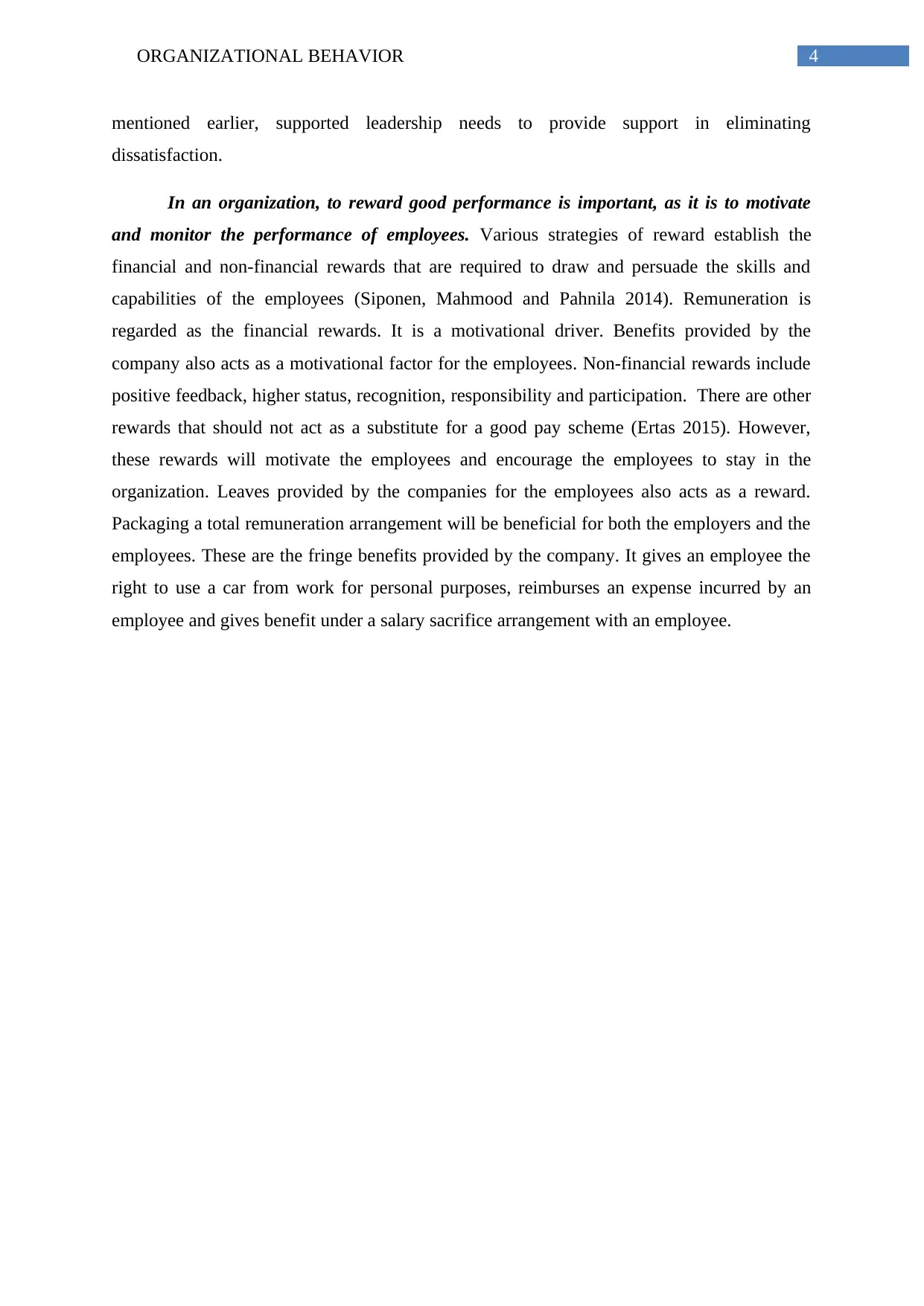
4ORGANIZATIONAL BEHAVIOR
mentioned earlier, supported leadership needs to provide support in eliminating
dissatisfaction.
In an organization, to reward good performance is important, as it is to motivate
and monitor the performance of employees. Various strategies of reward establish the
financial and non-financial rewards that are required to draw and persuade the skills and
capabilities of the employees (Siponen, Mahmood and Pahnila 2014). Remuneration is
regarded as the financial rewards. It is a motivational driver. Benefits provided by the
company also acts as a motivational factor for the employees. Non-financial rewards include
positive feedback, higher status, recognition, responsibility and participation. There are other
rewards that should not act as a substitute for a good pay scheme (Ertas 2015). However,
these rewards will motivate the employees and encourage the employees to stay in the
organization. Leaves provided by the companies for the employees also acts as a reward.
Packaging a total remuneration arrangement will be beneficial for both the employers and the
employees. These are the fringe benefits provided by the company. It gives an employee the
right to use a car from work for personal purposes, reimburses an expense incurred by an
employee and gives benefit under a salary sacrifice arrangement with an employee.
mentioned earlier, supported leadership needs to provide support in eliminating
dissatisfaction.
In an organization, to reward good performance is important, as it is to motivate
and monitor the performance of employees. Various strategies of reward establish the
financial and non-financial rewards that are required to draw and persuade the skills and
capabilities of the employees (Siponen, Mahmood and Pahnila 2014). Remuneration is
regarded as the financial rewards. It is a motivational driver. Benefits provided by the
company also acts as a motivational factor for the employees. Non-financial rewards include
positive feedback, higher status, recognition, responsibility and participation. There are other
rewards that should not act as a substitute for a good pay scheme (Ertas 2015). However,
these rewards will motivate the employees and encourage the employees to stay in the
organization. Leaves provided by the companies for the employees also acts as a reward.
Packaging a total remuneration arrangement will be beneficial for both the employers and the
employees. These are the fringe benefits provided by the company. It gives an employee the
right to use a car from work for personal purposes, reimburses an expense incurred by an
employee and gives benefit under a salary sacrifice arrangement with an employee.
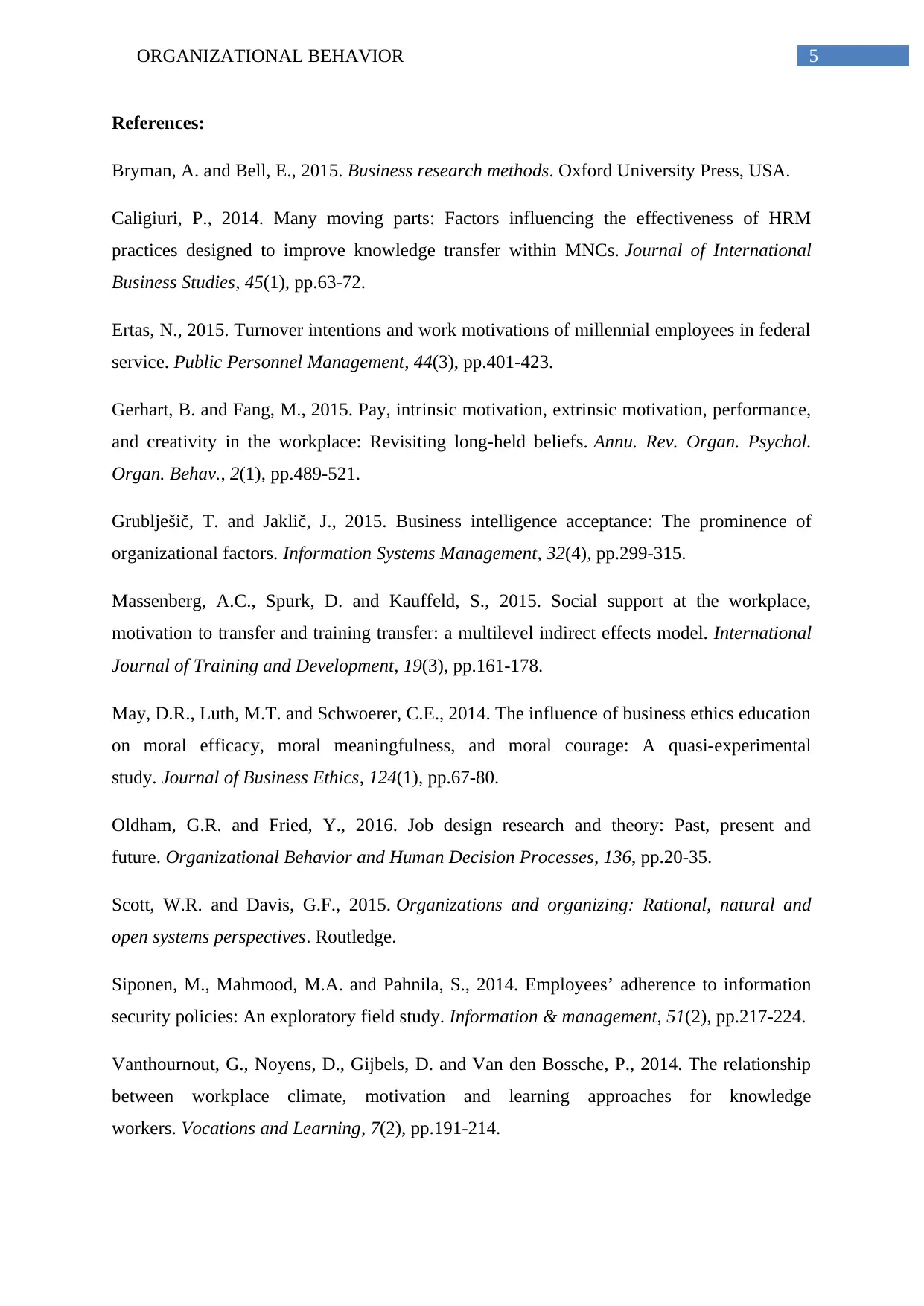
5ORGANIZATIONAL BEHAVIOR
References:
Bryman, A. and Bell, E., 2015. Business research methods. Oxford University Press, USA.
Caligiuri, P., 2014. Many moving parts: Factors influencing the effectiveness of HRM
practices designed to improve knowledge transfer within MNCs. Journal of International
Business Studies, 45(1), pp.63-72.
Ertas, N., 2015. Turnover intentions and work motivations of millennial employees in federal
service. Public Personnel Management, 44(3), pp.401-423.
Gerhart, B. and Fang, M., 2015. Pay, intrinsic motivation, extrinsic motivation, performance,
and creativity in the workplace: Revisiting long-held beliefs. Annu. Rev. Organ. Psychol.
Organ. Behav., 2(1), pp.489-521.
Grublješič, T. and Jaklič, J., 2015. Business intelligence acceptance: The prominence of
organizational factors. Information Systems Management, 32(4), pp.299-315.
Massenberg, A.C., Spurk, D. and Kauffeld, S., 2015. Social support at the workplace,
motivation to transfer and training transfer: a multilevel indirect effects model. International
Journal of Training and Development, 19(3), pp.161-178.
May, D.R., Luth, M.T. and Schwoerer, C.E., 2014. The influence of business ethics education
on moral efficacy, moral meaningfulness, and moral courage: A quasi-experimental
study. Journal of Business Ethics, 124(1), pp.67-80.
Oldham, G.R. and Fried, Y., 2016. Job design research and theory: Past, present and
future. Organizational Behavior and Human Decision Processes, 136, pp.20-35.
Scott, W.R. and Davis, G.F., 2015. Organizations and organizing: Rational, natural and
open systems perspectives. Routledge.
Siponen, M., Mahmood, M.A. and Pahnila, S., 2014. Employees’ adherence to information
security policies: An exploratory field study. Information & management, 51(2), pp.217-224.
Vanthournout, G., Noyens, D., Gijbels, D. and Van den Bossche, P., 2014. The relationship
between workplace climate, motivation and learning approaches for knowledge
workers. Vocations and Learning, 7(2), pp.191-214.
References:
Bryman, A. and Bell, E., 2015. Business research methods. Oxford University Press, USA.
Caligiuri, P., 2014. Many moving parts: Factors influencing the effectiveness of HRM
practices designed to improve knowledge transfer within MNCs. Journal of International
Business Studies, 45(1), pp.63-72.
Ertas, N., 2015. Turnover intentions and work motivations of millennial employees in federal
service. Public Personnel Management, 44(3), pp.401-423.
Gerhart, B. and Fang, M., 2015. Pay, intrinsic motivation, extrinsic motivation, performance,
and creativity in the workplace: Revisiting long-held beliefs. Annu. Rev. Organ. Psychol.
Organ. Behav., 2(1), pp.489-521.
Grublješič, T. and Jaklič, J., 2015. Business intelligence acceptance: The prominence of
organizational factors. Information Systems Management, 32(4), pp.299-315.
Massenberg, A.C., Spurk, D. and Kauffeld, S., 2015. Social support at the workplace,
motivation to transfer and training transfer: a multilevel indirect effects model. International
Journal of Training and Development, 19(3), pp.161-178.
May, D.R., Luth, M.T. and Schwoerer, C.E., 2014. The influence of business ethics education
on moral efficacy, moral meaningfulness, and moral courage: A quasi-experimental
study. Journal of Business Ethics, 124(1), pp.67-80.
Oldham, G.R. and Fried, Y., 2016. Job design research and theory: Past, present and
future. Organizational Behavior and Human Decision Processes, 136, pp.20-35.
Scott, W.R. and Davis, G.F., 2015. Organizations and organizing: Rational, natural and
open systems perspectives. Routledge.
Siponen, M., Mahmood, M.A. and Pahnila, S., 2014. Employees’ adherence to information
security policies: An exploratory field study. Information & management, 51(2), pp.217-224.
Vanthournout, G., Noyens, D., Gijbels, D. and Van den Bossche, P., 2014. The relationship
between workplace climate, motivation and learning approaches for knowledge
workers. Vocations and Learning, 7(2), pp.191-214.
⊘ This is a preview!⊘
Do you want full access?
Subscribe today to unlock all pages.

Trusted by 1+ million students worldwide
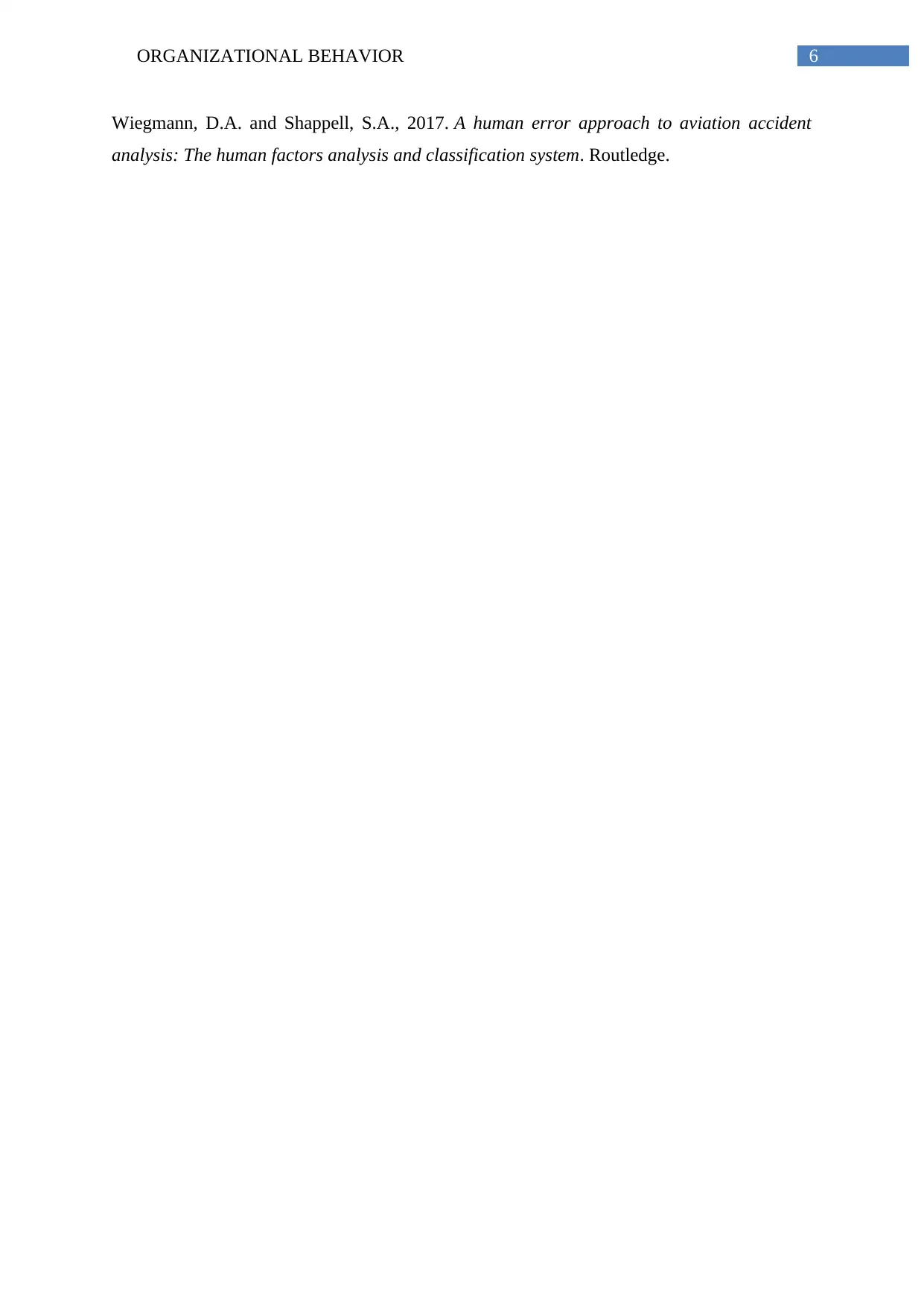
6ORGANIZATIONAL BEHAVIOR
Wiegmann, D.A. and Shappell, S.A., 2017. A human error approach to aviation accident
analysis: The human factors analysis and classification system. Routledge.
Wiegmann, D.A. and Shappell, S.A., 2017. A human error approach to aviation accident
analysis: The human factors analysis and classification system. Routledge.
1 out of 7
Related Documents
Your All-in-One AI-Powered Toolkit for Academic Success.
+13062052269
info@desklib.com
Available 24*7 on WhatsApp / Email
![[object Object]](/_next/static/media/star-bottom.7253800d.svg)
Unlock your academic potential
Copyright © 2020–2025 A2Z Services. All Rights Reserved. Developed and managed by ZUCOL.





